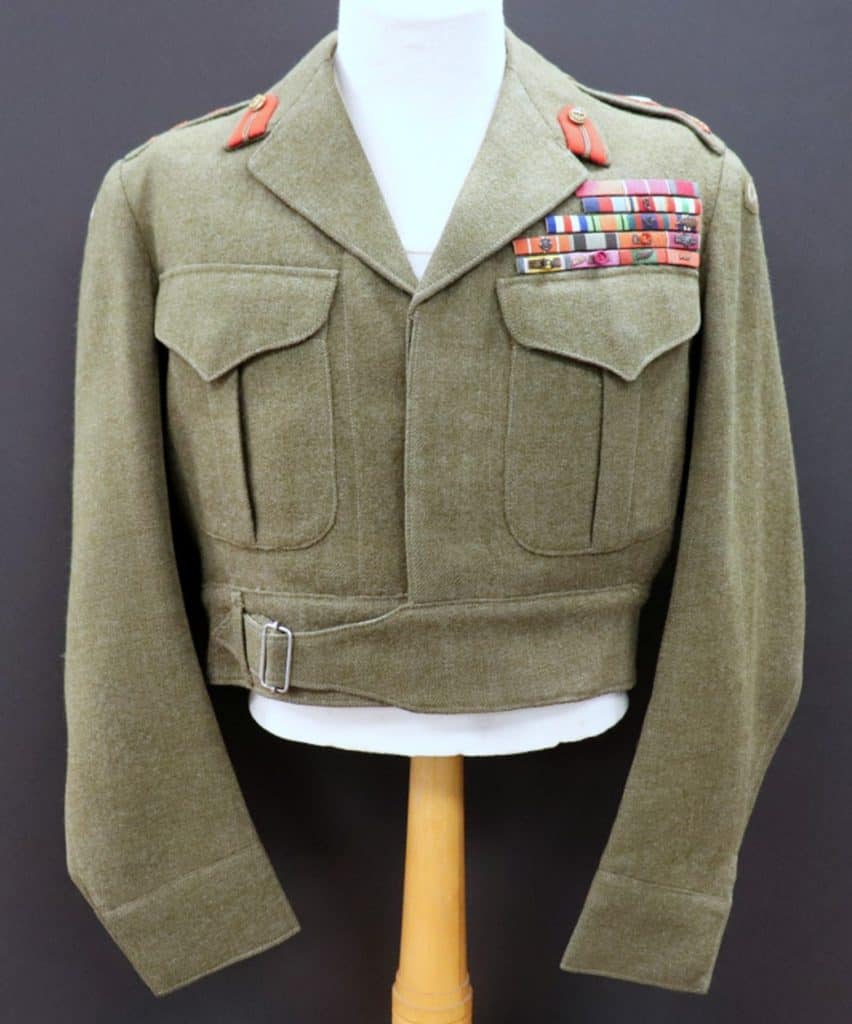A Tailored Battle Dress Tunic
From 1939 to the 1960s, Canadian soldiers wore Battle Dress as their standard military attire. Canadian manufacturers made the uniform from 20-ounce drab wool serge, consisting of a tunic and trousers. At the RCA Museum, we have a significant collection of uniforms, many manufactured and worn during WW2. Private tailors often altered the tunic for better fit and functionality. Tailoring was a common practice, especially for commissioned officers.
Canada produced two main patterns of Battle Dress tunics (Pattern 1939 and Pattern 1947), with subvariants, in thirty-two sizes to fit soldiers of different body types. The Canadian Military stamped each uniform on the inside lining behind one of the breast pockets. The stamp would contain various details, including the name, “Battledress, Blouse Serge,” size, height range, breast range, and manufacturer.
The British Army adopted the original Battle Dress pattern in March 1939, and Canada adopted it in September 1939. The British model was brown, but the Canadians changed the colour to a darker shade of green. Each pattern had distinguishing characteristics to tell them apart. Canadian Pattern 1939 included two pleated breast pockets, five concealed buttons down the front and significant pleating down the back. Canada issued the original model from 1939 to 1947.
The British designed a simplified version called Pattern 1940, with two plain-cut breast pockets and unhidden front buttons, but it was not widely available for Canadians. After WW2, designers relaxed the Battle Dress template, introducing Pattern 1947. The main features included two pleated breast pockets, five concealed buttons down the front and two pleats or minimal pleating down the back. The Permanent Force wore Pattern 1947 until the introduction of Combat Dress in 1963/64. The Reserves wore it until 1969/70.
The RCA Museum has dozens of Pattern 1939 & 1947 Battle Dress tunics. Every artifact is unique, and no two tunics are identical. One particular tunic catches the eye due to its distinctive, standout features. This piece of clothing has been carefully crafted using high-quality wool serge and reinforced stitching. The absence of Canadian stamps on the tunic indicates that it was not a part of the Canadian supply chain.

The photograph shows a 1956-era, tailored Battle Dress tunic with a Lieutenant-General rank.
The garment was made by J. Daniels & Co. Ltd., from Woolwich, London, England. They were a leading British supplier of uniforms and swords to the Royal Artillery during the 19th and 20th centuries. They specialized in producing top-quality and high-end uniforms for soldiers. J. Daniels & Co. Ltd. took in the waistline and shortened the overall length. On unaltered Battle Dress tunics, the distance between the bottom of the breast pocket and the top of the waist buckle was approximately 4 inches. In this case, it was a minimal 1 inch, resulting in a reduction of 3 inches. The tailor replaced the green wool serge liner with a red satin liner. They made two inside breast pockets, slimmed the chest width, and upgraded the stitching. The garment was top-class, dignified, and unique, just like the soldier who originally wore it.
The Battle Dress tunic is a historical artifact belonging to Lieutenant-General Guy G. Simonds, a distinguished field general during WW2. He commanded II Canadian Corps and led 150,000 Canadian troops during the Normandy Campaign, Northwest Europe Campaign, and the final push across the Rhine into Germany in 1944 and 1945. General Simonds was well-known for his self-discipline, neatly trimmed moustache, penetrating gaze, and impeccable uniform. General Simonds served as Chief of the General Staff from 1951 to 1956 and then retired. We are fortunate to have this unique artifact in our collection.
By Andrew Oakden
